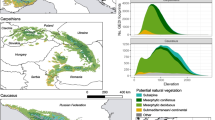Abstract
In a previous article, Beschta et al. (Environ Manag 51(2):474–491, 2013) argue that grazing by large ungulates (both native and domestic) should be eliminated or greatly reduced on western public lands to reduce potential climate change impacts. The authors did not present a balanced synthesis of the scientific literature, and their publication is more of an opinion article. Their conclusions do not reflect the complexities associated with herbivore grazing. Because grazing is a complex ecological process, synthesis of the scientific literature can be a challenge. Legacy effects of uncontrolled grazing during the homestead era further complicate analysis of current grazing impacts. Interactions of climate change and grazing will depend on the specific situation. For example, increasing atmospheric CO2 and temperatures may increase accumulation of fine fuels (primarily grasses) and thus increase wildfire risk. Prescribed grazing by livestock is one of the few management tools available for reducing fine fuel accumulation. While there are certainly points on the landscape where herbivore impacts can be identified, there are also vast grazed areas where impacts are minimal. Broad scale reduction of domestic and wild herbivores to help native plant communities cope with climate change will be unnecessary because over the past 20–50 years land managers have actively sought to bring populations of native and domestic herbivores in balance with the potential of vegetation and soils. To cope with a changing climate, land managers will need access to all available vegetation management tools, including grazing.
Similar content being viewed by others

References
Armour CL, Duff DA, Elmore W (1991) The effects of livestock grazing on riparian and stream ecosystems. Am Fish Soc 1991:7–11
Austin DD, Urness PJ, Durham SL (1994) Impacts of mule deer and horse grazing on transplanted shrubs for revegetation. J Range Manag 47:8–11
Beschta RL, Donahue DL, DellaSala DA, Rhodes JJ, Karr JR, O’Brien MH, Fleischner TL, Williams CD (2013) Adapting to climate change on western public lands: addressing the ecological effects of domestic, wild, and feral ungulates. Environ Manag 51(2):474–491
Blackburn WH (1984) Impacts of grazing intensity and specialized grazing systems on watershed characteristics and responses. Developing strategies for rangeland management. National Research Council Westview Press, Boulder, CO, pp 927–983
Boyd CS, Svejcar TJ (2009) Managing complex problems in rangeland ecosystems. Rangel Ecol Mang 2:491–499
Chaney E, Elmore W, Platts WS (1993) Managing change: livestock grazing on western riparian areas. Report prepared for the Environmental Protection Agency. Northwest Resource Information Center, Eagle, ID
Clark PE, Krueger WC, Bryant LD, Thomas DR (2000) Livestock grazing effects on forage quality of elk winter range. J Range Manag 3:97–105
Davies KW, Svejcar TJ, Bates JD (2009) Interaction of historical and nonhistorical disturbances maintains native plant communities. Ecol Appl 19:1536–1545
Diamond JM, Call CA, Devoe N (2012) Effects of targeted grazing and prescribed burning on community and seed dynamics of a downy brome (bromus tectorum)—dominated landscape. Invasive Plant Sci Manag 5:259–269
Follett RF, Kimble JM, Lal R (eds) (2001) The potential of US grazing lands to requester carbon and mitigate the greenhouse effect. Lewis Publishers, Boca Raton, FL, p 442
Fuhlendorf SD, Harrell WC, Engle DM, Hamilton RG, Davis CA, Leslie DM Jr (2006) Should heterogeneity be the basis for conservation? Grassland bird response to fire and grazing. Ecol Appl 16(5):1706–1716
George MR, Jackson RD, Boyd CS, Tate KW (2011) A scientific assessment of the effectiveness of riparian management practices. In: Briske DD (ed) Conservation benefits of rangeland practices: assessment, recommendations, and knowledge gaps. Allen Press, Lawrence, KS, p 429
Heitschmidt RK, Stuth JW (eds) (1991) Grazing management: an ecological perspective. Timber Press, Inc., Portland, OR, p 264
Lal R (2001) Soil erosion and carbon dynamics on grazing land. In: Follett RF, Kimble JM, Lal R (eds) Potential of US grazing lands to sequester carbon and mitigate the greenhouse effect. CRC, Boca Raton, FL
Love LD (1959) Rangeland watershed management. In: Proceedings, Society of American Foresters, 198–200
Rimbey NR, Darden TD, Torell LA, Tanaka JA, Van Tassell LW, Wulfhorst JD (2003) Ranch level economic impacts of public land grazing policy alternatives in the Bruneau Resource Area of Owyhee County, Idaho. University of Idaho Agricultural Economic Extension Service No. 03-05. Moscow, ID
Tanaka JA, Rimbey NR, Torell LA, DelCurto T, Bailey D, Walburger K, Taylor D, Welling B (2007) Grazing distribution: the quest for the silver bullet. Rangelands 29:38–46
The Wildlife Society (2010) Final position statement: Livestock grazing on rangelands in the western U.S. 5410 Grosvenor Lane, Bethesda, MD, 20814-2144
Torell LA, Tanaka JA, Rimbey NR, Darden T, Van Tassell L, Harp A (2002) Ranch-level impacts of changing grazing policies on BLM land to protect the greater sage-grouse: evidence from Idaho, Nevada, and Oregon. Policy Analysis Center for Western Public Lands Policy Paper SG-01-02
Wagner FH (1978) Livestock grazing and the livestock industry. In: Brokaw H (ed) Wildlife in America. Council on Environmental Quality, Washington, DC, pp 121–145
Wyman S, Bailey DW, Borman M, Cote S, Eisner J, Elmore W, Leinard B, Leonard S, Reed F, Swanson S, Van Riper L, Westfall T, Wiley R, Winward A (2006) Riparian area management: grazing management processes and strategies for riparian-wetland areas. Technical Reference 1737-20. BLM/ST/ST-06/002+1737. US Department of the Interior, Bureau of Land Management, National Science and Technology Center, Denver, CO, p 105
Ziska LH, Reeves JB III, Blank B (2005) The impact of recent increases in atmospheric CO2 on biomass production and vegetative retention of Cheatgrass (Bromus tectorum): implications for fire disturbance. Glob Chang Biol 11:1322–1325
Author information
Authors and Affiliations
Corresponding authors
Additional information
Beschta et al. 2013 (see Literature cited)
Rights and permissions
About this article
Cite this article
Svejcar, T., Boyd, C., Davies, K. et al. Western Land Managers will Need all Available Tools for Adapting to Climate Change, Including Grazing: A Critique of Beschta et al.. Environmental Management 53, 1035–1038 (2014). https://doi.org/10.1007/s00267-013-0218-2
Received:
Accepted:
Published:
Issue Date:
DOI: https://doi.org/10.1007/s00267-013-0218-2



